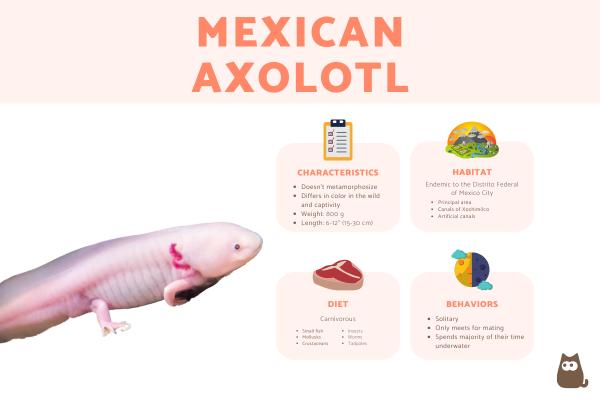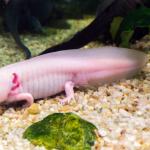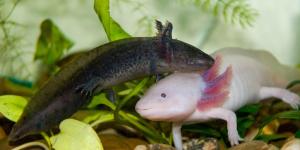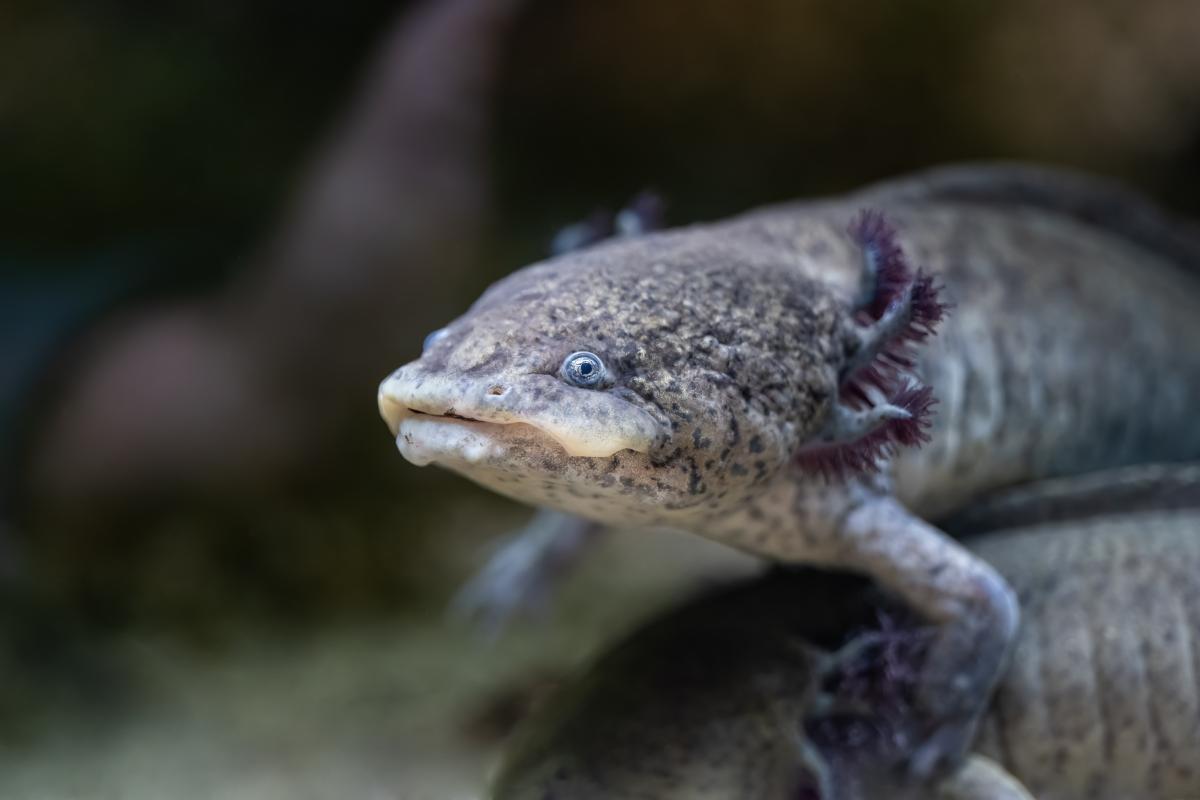Mexican Axolotl

The Mexican axolotl (Ambystoma mexicanum) is an amphibian that belongs to the family Ambystomatidae, a group which contains mole salamanders and Pacific giant salamanders. The axolotl is a member of the former group, of which there are more than 30 species in total. The axolotl is one of the most prominent, especially due to an increase in being kept as pets.
Among the aspects that stand out about the axolotl are the fact its entire species is located in a very small area (endemism), they have a very peculiar development within amphibians, the cultural links they have with their native Mexico and their current state of conservation. If you want to know in detail the characteristics of the Mexican axolotl such as its characteristics and behaviors, continue reading this animal file on the axolotl from AnimalWised.
- America
- Mexico
Characteristics of the Mexican axolotl
The main characteristic of the Mexican axolotl is the maintenance of larval traits even in adulthood. This is a biological phenomenon known as neoteny. In this sense, an adult axolotl has physical traits which are more common in larval stages of development, such as the dorsal fin that runs almost the entire body and three pairs of gills that protrude from the base of the head towards the back. These gills resemble feathers. The reason for these distinct traits are due to this amphibian not going through metamorphosis like other amphibians. Discover more with our guide to animals that do go through metamorphosis.
The average size of the Mexican axolotl is generally 6" (15 cm). They can measure more, but they do not exceed 12" /(30 cm). The legs are short with four toes on the front feet and five on the rear. They do not have nails like lizards might have. The head is both wide and robust. The eyes are small and without eyelids. The body elongated and flattened on each side. Generally, the skin is smooth although it may have some rough areas that can only be seen up close.
The other peculiar physical characteristic of the axolotl is its coloration. In the wild, its tones are dark and appear as black, gray, brown or intense green. However, thanks to the expression of various genes for color and selective crosses, in captivity this animal can show a diversity of shades that are dissimilar to each other. In this way we can find black, albino, pink albinos, white albinos, golden albinos and leucistic (white with black eyes) axolotls.
Mexican axolotl habitat
The Mexican axolotl was previously distributed in various habitats of the central valley of Mexico, made up of lakes and wetlands. Despite being an amphibian species, it lives exclusively in bodies of water. Currently, the Mexican axolotl only has a fairly narrow range of distribution, being found only in three specific places. These are the canals of Xochimilco (where the climate is temperate and subhumid), Lake Chalco and Lake Chapultepec.
The Mexican axolotl requires a deep-water habitat, whether natural lakes or artificial canals with the presence of abundant vegetation. They use this vegetations for reproduction, as well as to camouflage itself in the aquatic depths. The ecosystem for its development must be stable, both in composition and water flow. Turbidity, oxygen concentration and temperature that do not exceed 20 to 22 ºC (68 to 72 ºF) are important requirements for the habitat of the Mexican axolotl. The axolotl is a native and endemic species of the Federal District of Mexico.
Learn more about aquatic animals with our article on the difference between reptiles and amphibians.
Mexican axolotl behaviors
The Mexican axolotl has solitary and elusive habits, meeting with other individuals almost exclusively for mating. It spends most of its time submerged in murky bottoms of its aquatic habitat, breathing by gas exchange through the gills that it maintains even when it is an adult. As it also has moderately developed lung sacs, it can eventually reach the surface of the water and take in air.
This animal has a close relationship with the inhabitants of Mexico, not only from a scientific point of view. It is highly studied for its peculiarities, but culturally it also has an important meaning. In relation to the latter, its name means water dog in its original Aztec language. It is linked to the deities of the country's culture. In addition, it is a species that lives in captivity very frequently.
Mexican axolotl diet and feeding
If you are wondering what the Mexican axolotl eats, you should know it is a carnivorous animal. It has a varied diet when it lives in the wild. In this sense, it can consume small fish, as well as tadpoles, insects, worms, mollusks and freshwater crustaceans. When they are born, they preferentially choose copepods, water fleas and rotifers.
In captivity, their diet varies and they are fed worms, crickets, and mealworms. They can also digest pieces of meat, chicken, turkey or beef and commercial food for turtles. When feeding, they suck the water and hold the prey with their teeth, then swallow it whole. They can also practice cannibalism, making them quite a fierce creature, despite their adorable appearance.
Learn more about axolotl diet with our article on what do axolotls eat?
Mexican axolotl reproduction
The Mexican axolotl reaches maturity at approximately 1.5 years of age and reproduces only once a year between the months of December to February. They are an animal that displays sexual dimorphism, since males differ by having a cloaca that is longer than the females.
In these animals, a courtship phase takes place, curing which they get together and do a kind of dance. Afterwards, the male moves away from the female a little and performs a series of movements to finally release their spermatophore. The female then collects it and introduces it into her body so that fertilization occurs internally.
Once fertilization occurs, it takes approximately 24 hours for the female to release up to 1,500 eggs. She will then gradually deposit her eggs over the course of a few days. This process is done by placing the eggs in the aquatic plants present in the habitat, so that they are camouflaged and protected from predators. In a period of between 11 to 15 days , the birth of the offspring will occur.
Conservation status of the Mexican axolotl
The Mexican axolotl is declared critically endangered by the International Union for Conservation of Nature (IUCN). The Mexican axolotl is a terribly endangered species, so if the necessary measures are not implemented for its population stabilization, it will become extinct in nature.
Water pollution and the drying out of these bodies are the main cause of the deterioration of the habitat of the Mexican axolotl and of its significant population decline. Although international trade in the species for breeding as pets and consuming its meat seems to have stopped, these are still reasons that impact it.
There is an action plan for the Mexican axolotl that includes the maintenance of several international hatcheries, although these are mainly focused on the studies carried out on the animal. It has been included in Appendix II of the Convention on International Trade in Endangered Species of Wild Fauna and Flora, although it is currently undergoing periodic review. Because the main cause of its risk of extinction is habitat alteration, there are also some educational plans linked to tourism and the care of nature.
Mexican Axolotl photos
















